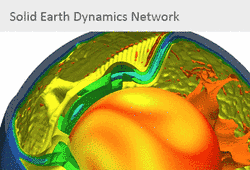Towards magnetic sounding of the Earth's core by an adjoint method; Kuan Li, Andrew Jackson (ETHZ), Philip W. Livermore (University of Leeds)
Earth's magnetic field is generated and sustained by the so called geodynamo system in the core. Measurements of the geomagnetic field taken at the surface, downwards continued through the electrically insulating mantle to the core-mantle boundary (CMB), provide primary constraints on the time evolution of the velocity, magnetic field and temperature anomaly in the fluid outer core. The aim of any study in data assimilation applied to the Earth's core is to produce a time-dependent model consistent with these observations [Fournier et al, 2010]. Snapshots of these "tuned" models provide a window through which the inner workings of the Earth's core, usually hidden from view, can be probed.
We apply a variational data assimilation framework to an inertia-free magnetohydrodynamic system (MHD) [Glatzmaier and Roberts, 1995]. Such a model is close to magnetostrophic balance [Taylor, 1963], to which we have added viscosity to the dominant forces of Coriolis, pressure, Lorentz and buoyancy, believed to be a good approximation of the Earth's dynamo in the convective time scale. We chose to study the MHD system driven by a static temperature anomaly to mimic the actual inner working of Earth's dynamo system, avoiding at this stage the further complication of solving for the time dependent temperature field. At the heart of the models is a time-dependent magnetic field to which the core-flow is enslaved.
In our previous work we laid the foundation of the adjoint methodology, applied to a subset of the full equations [Li et al, 2011]. As an intermediate step towards our ultimate vision of applying the techniques to a fully dynamic mode of the Earth's core tuned to geomagnetic observations, we present the intermediate step of applying the adjoint technique to the inertia-free Navier-Stokes equation in continuous form. We use synthetic observations derived from evolving a geophysically-reasonable magnetic field profile as the initial condition of our MHD system. Based on our study, we also propose several different strategies for accurately determining the entire trajectory of Earth's geodynamo system.
We solve this MHD system and its adjoint using a spectral method, due to its rapid convergence, where the magnetic field and the incompressible flow are represented by poloidal-toroidal fields and are further expanded in terms of spherical harmonics and specially constructed radial basis functions satisfying the relevant boundary conditions associated with the magnetic field and the flow. At the current stage of the numerical study of the geodynamo system, tens of thousands to millions of spectral coefficients for the magnetic and velocity field are to be solved at each time step and therefore can only be computed on a supercomputer with processors numbering several hundred to a thousand processors. Central to our numerical model are the facts that (i) the magnetic induction equation and its adjoint are parallelized in radius and (ii) the simplified Navier-Stokes equation is linear and diagnostic and is parallelised by symmetry class. The minimization step is computed on a single processor using the L-BFGS package, where at each assimilation cycle, the misfit and the adjoint field (representing the downhill direction) are collected from each processor.

